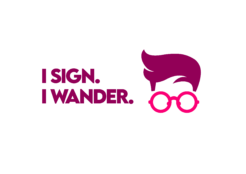
Deaf Stories was originally established with a vision of deaf people sharing their experiences as business owners. With Janelle Whalan as my filming assistant, we interviewed four deaf people – Neil Wood, Bobbie Blackson, and Ivan Callaghan & Nicole Cooke about their businesses. The first round of Deaf Stories was funded by Deaf Services’ Life Enrichment Grant which helped us to cover expenses such as travel, software, equipment and other costs associated with Deaf Stories.
After filming, editing and releasing each interview, the engagement from the deaf community I envisioned wasn’t happening. Something was missing.
I saw there was a dire need for deaf people to share their stories on a public platform. With deaf clubs disappearing from our very own eyes, where were opportunities for deaf people to share their stories in a casual and relaxing environment?
One of my favourite memories from my childhood was when deaf children from various schools across Southeast Queensland would get together for a day to celebrate Deafness Awareness Week at New Farm Park in Brisbane. Every year I wound find myself sitting with my fellow deaf peers watching Julie Lyons tell stories through Auslan and visual vernacular. The feeling of being captivated and being taken into another world through a deaf person’s storytelling skills – that was something I carried with me for so many years. I still carry this feeling with me today.
Deaf people are notorious for being excellent storytellers. This is because storytelling is a fundamental part of the deaf community. Ledwith (2011) stated that stories act as social-cultural glue, which means they define societies, cultures, and communities. Like sign language, storytelling acts as glue to bring the deaf community together.
For the second round of Deaf Stories, I was planning on reframing it to include stories from various deaf people around the country. My original plans were thrown out of the window when Australia was hit by the COVID-19 pandemic. With travel restrictions in place, this meant I was now unable to travel around the country collecting stories from deaf and hard of hearing Australians.
The first couple of weeks in lockdown, I watched numerous creators change their plans and projects. I also saw a number of friends in the arts make changes to their projects. Everything had to be moved online. That gave me the idea: why not make Deaf Stories an online platform for the deaf community watch interviews happen in real time? Give the deaf community a sense of belonging, similar to being at a deaf club. Hence the decision to reframe it as Deaf Stories LIVE.
The first Deaf Stories LIVE interview with Andrew Wiltshire was a huge success. I saw the engagement I had longed to achieve. I saw deaf, hard of hearing and hearing people respond to the interview.
Through the first interview, Andrew displayed his skills as a brilliant storyteller. According to Davis Haggerty (2007), being a skilled storyteller becomes an influential trait in the deaf community. Andrew is considered a role model to many deaf people.
Role models like Andrew are essential in the deaf community, particularly for young deaf people who are still figuring out their identities. Young deaf people should have access to role models within the deaf community, as Sutton-Spence (2010) believes it helps young deaf people to develop their personal, linguistic, and social identities.
Nović (2016) says deaf culture is founded on storytelling; it’s a culture obsessed with its own language. With the use of sign language such as Auslan, we work on the art of storytelling in various forms such as poetry, visual vernacular, sign singing, etc. It’s not something that is perfected overnight; it takes a lot of practice and consultation by our fellow deaf peers to ensure the stories are easy to understand through Deaf eyes.
Deaf people often learn best through storytelling. We are encouraged to participate through participation and understanding; belonging and confidence grows as we are listened to, valued and taken seriously (Ledwith, 2011). Without storytelling, how can change occur within the deaf community? How can we learn about the world around us? How can we connect with the deaf community using the Deaf experience?
“We tell our stories to transform ourselves; to learn about our history and tell our experiences to transcend them; to use our stories to make a difference in our world; to broaden our perspective to see further than normal; to act beyond a story that may have imprisoned or enslaved us; to live more of our spiritual and earthly potential.” ~ Rachel Freed (2011)
Storytelling empowers deaf and hard of hearing people to share their experiences; to start discussion; and to create change within the community and in the mainstream. Change doesn’t occur without sharing personal stories. Stories also encourages us to connect with and understand each other better.
I strongly believe in the power of storytelling and it’s why I chose to frame Deaf Stories around the notion of storytelling we have come to know and enjoy for many years within the deaf community.
In my next blog/vlog, I will be talking about vulnerability and why it’s an important element in storytelling.
Big love,
S x
References:
Davis Haggerty, L. (2007). Storytelling and leadership in the Deaf community. Rochester Institute of Technology, USA.
Freed, R. (2011). The Importance of Telling Our Stories.
Ledwith, M. (2011). Chapter Three: Doing Community Development in Community Development – A Critical Approach.
Nović, S. (2016). At Home in Deaf Culture: Storytelling in an Un-Writable Language.
Sutton-Spence, R. (2010). The Role of Sign Language Narratives in Developing Identity for Deaf Children. Journal of Folklore Research.

Pingback: April Book List – Penn Hills Library